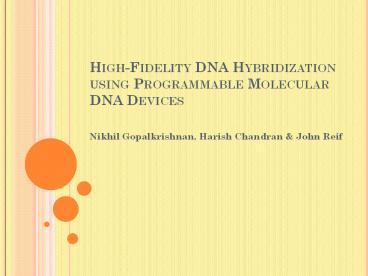High-Fidelity DNA Hybridization using Programmable Molecular DNA Devices - PowerPoint PPT Presentation
Title:
High-Fidelity DNA Hybridization using Programmable Molecular DNA Devices
Description:
HIGH-FIDELITY DNA HYBRIDIZATION USING PROGRAMMABLE MOLECULAR DNA DEVICES Nikhil Gopalkrishnan, Harish Chandran & John Reif – PowerPoint PPT presentation
Number of Views:100
Avg rating:3.0/5.0
Title: High-Fidelity DNA Hybridization using Programmable Molecular DNA Devices
1
High-Fidelity DNA Hybridization using
Programmable Molecular DNA Devices
- Nikhil Gopalkrishnan, Harish Chandran John Reif
2
Fidelity of Hybridization
Perfect hybridization
Mismatched hybridization
Difference in energy between red strand
hybridization and green strand hybridization is
small
3
Fidelity of Hybridization
- Hybridization fidelity depends on length
- Errors in hybridization
- Noise Strands with sequence similar to the
target
4
Drawbacks of Low Fidelity Self-Assembly
5
Drawbacks of Low Fidelity Self-Assembly
6
Drawbacks of Low Fidelity DNA Microarrays
From http//en.wikipedia.org/wiki/FileNA_hybrid.
svg
7
Exact High-Fidelity Hybridization
- Solution ensemble of distinct sequences
- Target sequence s
- Problem statement Completely hybridize all
- copies of s and dont hybridize any other
sequence - Multiple strands may bind to s and cooperatively
hybridize it
8
Exact High-Fidelity Hybridization
- Solution ensemble of distinct sequences
- Target sequence s
- Problem statement Completely hybridize all
- copies of s and dont hybridize any other
sequence - Multiple strands may bind to s and cooperatively
hybridize it - Completion of hybridization should be detectable
- Example by fluoroscence
9
Approximate High-Fidelity Hybridization
- Hybridization Error
- At most b bases may mismatch b-hybridized
- Success probability
- probability of b-hybridization at least p
- Problem statement b-hybridize each copy of s
with probability at least p and no other sequence
is b-hybridized with probability greater than 1-p - p 95 and b 1/10th of length of s
10
Assumptions
- Short sequences have high fidelity of
hybridization - Subsequences sequestered in short hairpins are
unreactive - Strand displacement occurs whenever possible and
proceeds to completion
11
Approximate High-Fidelity Hybridization
12
Notation
- Letters represent sequences
- Example ci
- Sequences concatenate
- ci ai bi
- Written from 5 to 3
- Sequences differing only in the subscript are
concatenations of subsequences differing only in
the subscript - ci ai1 bi implies ci1 ai2 bi1
- Bar indicates reverse complement
- ci bi ai is the reverse complement of ci ai
bi
13
High-Fidelity Hybridization 1st Protocol
14
High-Fidelity Hybridization 1st Protocol
15
High-Fidelity Hybridization 1st Protocol
16
High-Fidelity Hybridization 1st Protocol
17
High-Fidelity Hybridization 1st Protocol
18
High-Fidelity Hybridization 1st Protocol
19
1st Protocol Potential Source of error
20
1st Protocol Potential Source of error
21
1st Protocol Potential Source of error
22
High-Fidelity Hybridization 2nd Protocol
23
High-Fidelity Hybridization 2nd Protocol
24
High-Fidelity Hybridization 2nd Protocol
25
High-Fidelity Hybridization 2nd Protocol
26
High-Fidelity Hybridization 2nd Protocol
27
High-Fidelity Hybridization 2nd Protocol
28
Favorable Properties of the Protocols
- Autonomous
- Fluorophore based detection
29
Simulation of Finite Automata
- Finite automata Mathematical constructs that
define languages - Limited computational power
- Memoryless
30
Simulation of Finite Automata
- Target strand encodes input to automata
- Checker sequences perform state transitions
- Green sequence performs d(y,0) z
31
Simulation of Finite Automata
- Incorrect checker sequence may attach
- Further attachment is blocked as second hairpin
doesnt open - At each step, probability of correct attachment
0.5 - Probability of successful completion 1/2 n
where nsize of i/p - Can process multiple inputs in parallel
- Number of checker sequences Twice number of
edges in the transition diagram of the automata
32
Protocol Kinetics
33
Future work
- Experimental verification for a simple case with
just two checker sequences - Computer simulation to predict reaction kinetics































